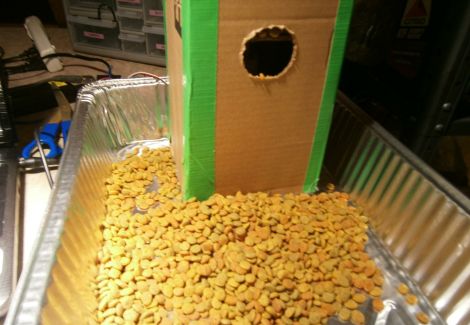[Will Finucane] of Revolt Labs/Mad Science Blog was looking for a way to keep his cats happily fed while away on a short vacation, so he put together a cheap and easy automatic feeder to ensure that his pets didn’t go hungry while he was away.
We’ve seen different iterations of automatic pet feeders here before, some relying on rotating false bottoms, while others use crank-style feeders to get the job done. [Will’s] solution is a bit different, employing a cheap linear actuator to deliver feedings.
He emptied out a glue stick, replacing the glue with a brass tube. This gives him the rigidity that the glue lacked, allowing him to easily move a platform full of cat food up and down. He mounted the glue stick on a continuous rotation servo, installing the actuator and a feeding platform inside a cardboard box.
Using an Arduino, he lowers the movable platform every 12 hours, allowing a bit of cat food to fall from the hole he cut in the side of the box. While his creation might not stand up to years of use, it’s a quick solution that can cost very little, depending on what you have sitting around.
Check out the video below to see [Will’s] cat feeder in action.
Continue reading “An Easy To Build Cat Feeder Driven By A DIY Linear Actuator” →














